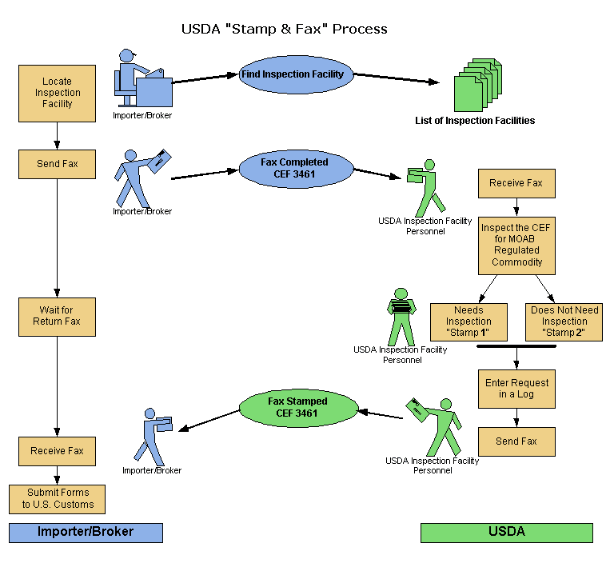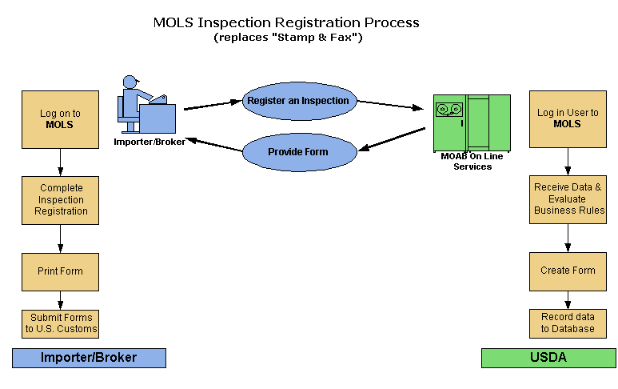|
The U.S. Department of Agriculture importation
regulations require that all imports of Section
8e regulated commodities must either be inspected
and meet the same grade and quality standards
of domestically produced commodities, or they
must be approved for exempt uses. The Market Order
Administration Branch (MOAB) is responsible for
the ensuring that the Import Community is in full
compliance with the Section 8e import regulation.
In excess of 120,000 shipments per year of over
30 different commodities are regulated (02/2003).
The MOLS system is one component of the database
system that enables MOAB to automatically identify
and characterize those imports which are not in
compliance and automatically contact those importers
alerting them of their non-compliance. This is
performed through the use of data acquired from
U.S. Customs and data integrated from MOLS. MOLS
closes all import entries that are in compliance
due to 'passed' inspections, destroyed or exported
shipment amounts (parts of the entry that failed
inspection), and qualified exempt entries or entry
portions. All unaccounted entries are deemed "probable
non-compliant". Correspondence to the non-compliant
importers is automatically generated including
details of each entry that is not accounted as
'closed'.
Additionally
the system provides a web-based facility for Imports
to register inspections with USDA to enable clearance
through Customs. This provided a replacement to
a "Stamp & Fax" workflow that required
considerable work and time among Importers as
well as USDA personnel. There was also a delay
in receipt of the artfact required to clear U.S.
Customs due to the reliance on humans faxing documents.
The "Stamp & Fax" workflow is illustrated
in Figure 1.0. The replacement "Web-based
Inspection Registration" workflow is illustrated
in Figure 2.0.
 Figure
1.0 "Stamp & Fax" Workflow Figure
1.0 "Stamp & Fax" Workflow
 Figure
2.0 "Web-based Inspection Registration"
Workflow. Figure
2.0 "Web-based Inspection Registration"
Workflow.
The
benefits of the "Web-based Inspection Registration"
over the "Stamp & Fax" include :
- dramatic
reduction in human time and effort, paperwork,
and defects (for government and business),
- increase
in compliance,
- the
"Inspection Registration" requires
less than 1 minute per Customs Entry, while
the "Stamp & Fax" may require
more than 24 hours.
- the
"Inspection Registration" will automatically
determine whether an inspection is required,
the "Stamp & Fax" relies on a
human - in fact over 100 different humans all
with a uniform interpretation and sometimes
having to call the Importer for additional information,
- the
"Inspection Registration" automatically
logs the entry in the database at the time of
the registration, the "Stamp & Fax"
requires USDA personnel to enter the data in
a database when they get around to it.
- the
"Inspection Registration" avoids over
240,000 phone calls per year, many of them long
distance.
- with
"Inspection Registration" the Importer
knows the outcome immediately and has the needed
certificate to allow their shipment to clear
U.S. Customs within the minute, with "Stamp
& Fax" they do not know when the certificate
will be sent, or even whether their fax was
received by a human.
- the
"Inspection Registration" is available
24 hours a day, 7 days a week, including holidays;
"Stamp & Fax" is available during
'office hours' and definitely not on holidays.
The
web-based "Inspection Registration"
provides the Importer with a standard Certificate
that is uniform across all ports of entry and
dates. This provides for enhanced enforcement
of USDA regulations by U.S. Customs Field Agents.
The certificates are auto-populated PDF files
that are downloaded or printed by the Importer
and presented at time of entry into the United
States. Every Certificate is Serialized and corresponds
to a U.S. Customs entry (or registered import).
The data on the form is provided by the "Inspection
Registration" database. USDA has all of the
data captured in real-time so that every Certificate
already has the data in the database at time of
certificate printing. Figure 3 is an example of
an Inspection Registration Certificate.
All
business rule structure was designed into the
database. This allows rule changes to be made
at any time - keeping pace with changes in the
regulations on commodities and which commodities
are regulated - by a data administrator without
making any code changes. This enables the Client
to operate and maintain the system without requiring
the on-going 'maintenance' work of a development
or technical services firm.
The
analysis tool suite was comprised of 22 summary
reports and graphics. In addition there are 4
correspondence generator objects, and 1 XML file
generator object. The XML file generator object
is used by the state inspection offices as a template
or class object for exporting data to MOLS in
a 'easy-to-implement' fashion.
This
application is a great example of how solid, stable,
affordable technologies can provide a tremendous
benefit to the hosting organization and their
related Citizens and Businesses.
The
entire FV6 Automated Certificate system was written
in Microsoft Studio.NET (C#), MS SQL2000, running
on IIS/Win2000 and using SMTP services for supporting
“Forgot Password” e-mailing.
All of the reports were written in Crystal
Reports.
|
|
Customer
Profile
Past
Performance
Agencies
and Companies
|